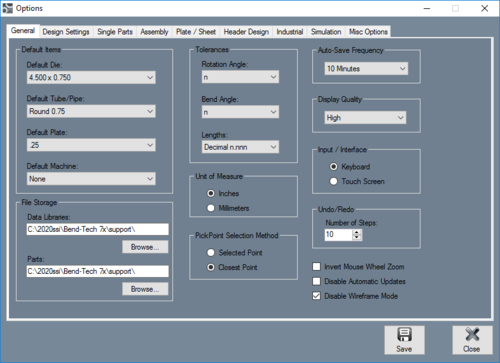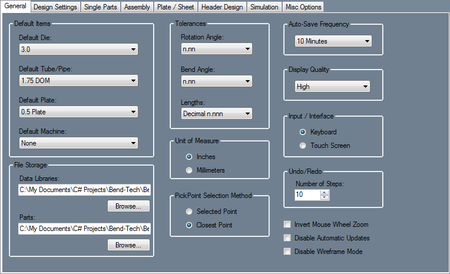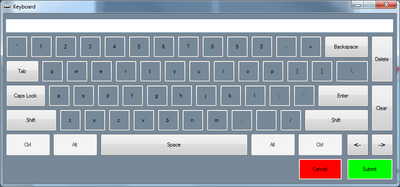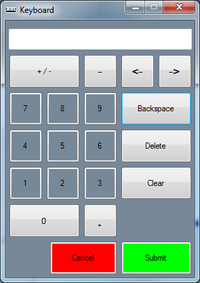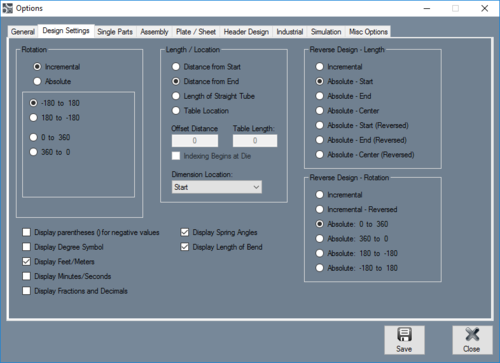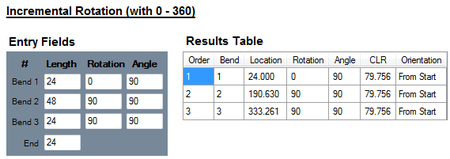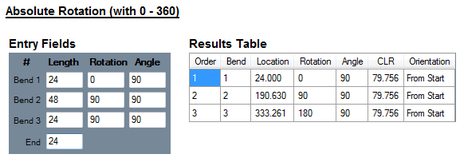Difference between revisions of "Options"
| Line 59: | Line 59: | ||
<h4>PickPoint Selection Method</h4> | <h4>PickPoint Selection Method</h4> | ||
| + | The PickPoint Selection Method will determine how pickpoints can be selected in the plate and assembly interfaces. The '''Selected Point''' option will require a point to be directly clicked on in order to be selected. The '''Closest Point''' option will select whichever point is closest to the cursor when it is clicked. | ||
| + | |||
<h4>Auto-Save Frequency</h4> | <h4>Auto-Save Frequency</h4> | ||
| + | Using the Auto-Save Frequency menu, the time interval between auto saves can be adjusted or the auto-save function can be turned off. This setting will affect any open designs throughout the software. | ||
| + | |||
<h4>Display Quality</h4> | <h4>Display Quality</h4> | ||
| + | The quality of the graphical representation of parts, plate designs, or assemblies can be adjusted. To change this setting, click on the drop down menu and choose either Low, Medium, or High. | ||
| + | |||
<h4>Input/Interface</h4> | <h4>Input/Interface</h4> | ||
| + | The type of input device being used with the software can be specified here. If a standard computer and keyboard is being used, the '''Keyboard''' option would be appropriate. If a touchscreen computer/computer without a keyboard is being used, select the '''Touch Screen''' option. When this option is chosen, a keyboard/number pad will open on-screen whenever text or a numerical value is needed to be entered. See the images below. | ||
| + | |||
| + | [[File:options_5.png|400px]] [[File:options_6.png|200px]] | ||
| + | |||
<h4>Undo/Redo</h4> | <h4>Undo/Redo</h4> | ||
| + | The number of steps allowed for redo/undos can be adjusted here. For example, if 10 is set as the number of steps, the undo button can be hit 10 times before it no longer has an affect on the plate or assembly design. There is a limit to 100 steps. | ||
| + | |||
| + | |||
| + | |||
| + | |||
| + | <h2>Design Settings</h2> | ||
| + | [[File:options_7.png|right|500px]] | ||
| + | |||
| + | <h4>Rotation</h4> | ||
| + | The rotation settings control how rotation values are displayed in the results table. Rotation can be measured in incremental or absolute terms. Each rotation angle range can also be chosen. | ||
| + | |||
| + | *'''Incremental:''' Rotation angles will start from the end of the previous bend's rotation. Click the incremental rotation option to select it. | ||
| + | |||
| + | ::[[File:options_8.png|450px]] | ||
| + | |||
| + | |||
| + | *'''Absolute:''' Rotation angles will always start from the very beginning of the angle scale. Click the absolute rotation option to select it. | ||
| + | |||
| + | ::[[File:options_9.png|460px]] | ||
| + | |||
| + | |||
| + | *'''Angle Scale:''' The rotation scale will determine what the rotation angles will range between. The rotation scale will show where the angle measurements begin and where they end. Choose a rotation scale by clicking on one of the scale options. The rotation scales available are '''0 - 360, 360 - 0, (-180) - 180, and 180 - (-180)'''. The '''0 - 90 - 0 - 90 - 0''' and '''0 - 90 - 0 - 90 - 0 Reversed''' options will be added when the '''Absolute''' option is chosen. | ||
| + | <h4>Display Settings</h4> | ||
| + | In the bottom left corner there will be a list of checkbox options to control the display options for the results table on single part designers. | ||
| + | |||
| + | *'''Display parentheses () for negative values:''' Check this box to have all negative values enclosed in parentheses. | ||
| + | |||
| + | *'''Display Degree Symbol:''' Check this box for angle values to have degree symbols shown next to them. | ||
| + | |||
| + | *'''Display Feet/Meters:''' Check this box for large length values to be displayed in terms of feet or meters (feet will be used if inches are used as the units and meters will be used if millimeters are the units.) | ||
| + | |||
| + | *'''Display Minutes/Seconds:''' Check this box for angle values to be displayed in terms of minutes and seconds instead of decimal values. | ||
| + | |||
| + | *'''Display Fractions and Decimals:''' | ||
| + | |||
| + | *'''Display Spring Angles:''' | ||
| + | |||
| + | *'''Display Length of Bend:''' | ||
| + | |||
| + | |||
| + | <h4>Length/Location</h4> | ||
| + | |||
| + | |||
| + | |||
| + | <h4>Reverse Design - Length</h4> | ||
| + | |||
| + | |||
| + | |||
| + | <h4>Reverse Design - Rotation</h4> | ||
| − | |||
<h2>Single Parts Tab</h2> | <h2>Single Parts Tab</h2> | ||
Revision as of 10:54, 2 June 2014
Bend-Tech 7x Wiki :: Main Menu Bar :: Tools :: Options
The Options menu contains default settings, visual preferences, and general settings for each area within the software.
This menu can be accessed by clicking the Tools option on the main menu bar and selecting Options from the drop down menu.
Additionally, when adjusting any of these settings, be sure to click the Save button ![]() at the bottom of the frame to apply the new defaults or settings. When any default settings are changed, any designs that are currently open will not be affected. Any new designs or designs opened after changes were made will have these settings applied.
at the bottom of the frame to apply the new defaults or settings. When any default settings are changed, any designs that are currently open will not be affected. Any new designs or designs opened after changes were made will have these settings applied.
General Tab
Default Items
- Default Die: In the Default Die menu, a die can be chosen and set as the default. Once a die is set as the default, it will be the die that is initially selected when a new single part is created. To set a default die, click the drop down menu and select a die from the list.
- Default Tube/Pipe: In the Default Tube/Pipe menu, a tube/pipe material can be chosen and set as the default. Once a material is set as the default, it will be the material that is initially selected when a new single part is created.
- Default Plate: In the Default Plate menu, a plate material can be chosen and set as the default. Once a plate material is set as the default, it will be the material that is initially selected when a new plate is created.
- Default Machine: In the Default Machine menu, a machine can be chosen and set as the default. Once a machine is set as the default, it will be the machine that is initially selected when a new part is created.
File Storage
The file storage locations will determine where data (die, material, plate, etc.) libraries and part files will be stored.
To choose a new location for the data libraries, click the Browse button ![]() below the data libraries location.
below the data libraries location.
To choose a default location for part files, click the Browse button ![]() below the parts location. This will be the folder that is initially opened when a part is being saved.
below the parts location. This will be the folder that is initially opened when a part is being saved.
Tolerances
The decimal tolerance for the lengths, angles, and rotations can be adjusted here. The decimal tolerance controls how many digits will be allowed after decimals points for length, angle, and rotation. In the tolerance options, each digit place is represented by an n.
For example, if the angle tolerance is set to n.nn and the actual angle is 90.539°, the angle will be rounded to 90.54°. If the angle tolerance is set to just n, then the angle would be rounded to 91°.
- Rotation Angle: To change the decimal tolerance for part rotation values, click the drop down menu and select a tolerance option from the list.
- Bend Angle: To change the decimal tolerance for bend angle values, click the drop down menu and select a tolerance option from the list.
- Lengths: Length values can be displayed in either fractional or decimal format. To change the format and/or tolerance for lengths, click the drop down menu and select an option from the list.
Unit of Measure
The measurement units can be set to either inches or millimeters. Once a unit of measure is chosen, it will be the unit of measure that is initially chosen wherever units of measure can be adjusted throughout the software.
PickPoint Selection Method
The PickPoint Selection Method will determine how pickpoints can be selected in the plate and assembly interfaces. The Selected Point option will require a point to be directly clicked on in order to be selected. The Closest Point option will select whichever point is closest to the cursor when it is clicked.
Auto-Save Frequency
Using the Auto-Save Frequency menu, the time interval between auto saves can be adjusted or the auto-save function can be turned off. This setting will affect any open designs throughout the software.
Display Quality
The quality of the graphical representation of parts, plate designs, or assemblies can be adjusted. To change this setting, click on the drop down menu and choose either Low, Medium, or High.
Input/Interface
The type of input device being used with the software can be specified here. If a standard computer and keyboard is being used, the Keyboard option would be appropriate. If a touchscreen computer/computer without a keyboard is being used, select the Touch Screen option. When this option is chosen, a keyboard/number pad will open on-screen whenever text or a numerical value is needed to be entered. See the images below.
Undo/Redo
The number of steps allowed for redo/undos can be adjusted here. For example, if 10 is set as the number of steps, the undo button can be hit 10 times before it no longer has an affect on the plate or assembly design. There is a limit to 100 steps.
Design Settings
Rotation
The rotation settings control how rotation values are displayed in the results table. Rotation can be measured in incremental or absolute terms. Each rotation angle range can also be chosen.
- Incremental: Rotation angles will start from the end of the previous bend's rotation. Click the incremental rotation option to select it.
- Absolute: Rotation angles will always start from the very beginning of the angle scale. Click the absolute rotation option to select it.
- Angle Scale: The rotation scale will determine what the rotation angles will range between. The rotation scale will show where the angle measurements begin and where they end. Choose a rotation scale by clicking on one of the scale options. The rotation scales available are 0 - 360, 360 - 0, (-180) - 180, and 180 - (-180). The 0 - 90 - 0 - 90 - 0 and 0 - 90 - 0 - 90 - 0 Reversed options will be added when the Absolute option is chosen.
Display Settings
In the bottom left corner there will be a list of checkbox options to control the display options for the results table on single part designers.
- Display parentheses () for negative values: Check this box to have all negative values enclosed in parentheses.
- Display Degree Symbol: Check this box for angle values to have degree symbols shown next to them.
- Display Feet/Meters: Check this box for large length values to be displayed in terms of feet or meters (feet will be used if inches are used as the units and meters will be used if millimeters are the units.)
- Display Minutes/Seconds: Check this box for angle values to be displayed in terms of minutes and seconds instead of decimal values.
- Display Fractions and Decimals:
- Display Spring Angles:
- Display Length of Bend:
Length/Location
Reverse Design - Length
Reverse Design - Rotation
